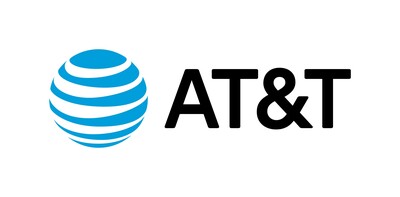AT&T Reports Strong Third-Quarter Financial Performance
AT&T Reports Strong Third-Quarter Financial Performance |
| [22-October-2025] |
Differentiated investment-led strategy continues to drive customer growth and advance AT&T's converged connectivity leadership DALLAS, Oct. 22, 2025 /PRNewswire/ -- AT&T Inc. (NYSE: T) reported strong third-quarter results that demonstrate continued customer demand for its nation-leading wireless and fiber offerings and position the Company to deliver on its full-year consolidated financial outlook. "We have the key building blocks in place to give our customers the best connectivity experience in the industry and we're winning the race to lead in convergence," said John Stankey, AT&T Chairman and CEO. "We continue to add highly-profitable customers that are choosing AT&T for all their connectivity needs on the country's fastest and largest wireless and fiber networks. It's clear our differentiated investment-led strategy is working, and we remain on track to achieve all of our 2025 consolidated financial guidance." Third-Quarter Consolidated Results
Third-Quarter Highlights
Announced Transaction Highlights The following includes a summary of recently announced transactions and expected financial impacts. Acquisition of fiber assets from Lumen:
Acquisition of wireless spectrum licenses from EchoStar:
Outlook AT&T reiterates all full-year 2025 financial guidance:
AT&T continues to operate the business to achieve the strategy outlined at its 2024 Analyst & Investor Day and updated with its second quarter 2025 earnings release, including $20 billion of capacity for share repurchases during 2025-2027. Accordingly, AT&T reiterates its 2026-2027 financial outlook:
The Company expects to maintain a consistent approach to capital returns during 2028-2029 while reducing its net debt-to-adjusted EBITDA ratio*, supported by improved long-term growth in service revenue, adjusted EBITDA* and strong free cash flow* from the Lumen and EchoStar transactions. Note: AT&T's third-quarter earnings conference call will be webcast at 8:30 a.m. ET on Wednesday, October 22, 2025. The webcast and related materials, including financial highlights, will be available at investors.att.com. Consolidated Financial Results
Segment and Business Unit Results Communications segment revenues were $29.5 billion, up 1.5% year over year, with operating income down 0.8% year over year.
Mobility service revenue grew 2.3% year over year driving operating income growth of 1.7% and EBITDA* growth of 2.2%. Postpaid phone net adds were 405,000.
Mobility revenues were up 3.1% year over year, with service revenue growth of 2.3% and equipment revenue growth of 6.1%, driven by higher wireless device sales volumes. Service revenue growth reflects subscriber gains partially offset by promotional activity and the impact of one-time revenues of $90 million related to administrative fees in the prior-year quarter. Operating expenses were up 3.8% year over year, reflecting increased equipment expense due to higher wireless sales volumes and the sale of higher-priced devices as well as increased advertising and promotional costs and depreciation expense. These increases were partially offset by lower expenses due to continued transformation initiatives and lower content licensing fees. Operating income was $7.1 billion, up 1.7% year over year. EBITDA* was $9.7 billion, up $0.2 billion year over year. Business Wireline revenues declined year over year driven by continued secular pressures on legacy and other transitional services, which were partially offset by growth in fiber and advanced connectivity services.
Business Wireline revenues were down 7.8% year over year due to continued declines in legacy and other transitional services of 17.3%, partially offset by 6.0% growth in fiber and advanced connectivity services. Operating expenses were down 1.0% year over year due to lower personnel and customer support costs associated with ongoing transformation initiatives. These decreases were partially offset by favorable vendor settlements in the prior-year quarter and higher depreciation expense from ongoing strategic investment initiatives, such as fiber and AT&T Internet Air. Operating income was $(354) million versus $(43) million in the year-ago quarter. EBITDA* was $1.2 billion, down $0.2 billion year over year. Consumer Wireline delivered strong broadband revenue growth driven by a 16.8% increase in fiber revenue. Consumer Wireline also delivered positive broadband net adds for the ninth consecutive quarter, driven by 288,000 AT&T Fiber net adds and 270,000 AT&T Internet Air net adds.
Consumer Wireline revenues were up 4.1% year over year driven by broadband revenue growth of 8.2% due to fiber revenue growth of 16.8%, partially offset by declines in legacy voice and data services and other services. Operating expenses were up 0.3% year over year due to higher depreciation expense driven by fiber investment and higher network-related costs. This was partially offset by lower content licensing fees, and customer support costs. Operating income was $325 million versus $196 million in the year-ago quarter. EBITDA* was $1.3 billion, up $0.2 billion year over year.
Latin America segment revenues were up 7.1% year over year, driven by subscriber and ARPU growth and higher equipment sales as well as the favorable impacts of foreign exchange rates. Operating expenses were up 6.0% due to higher equipment costs, selling costs, and bad debt expense resulting from higher sales, higher depreciation expense, and the unfavorable impacts of foreign exchange rates. Operating income was $22 million compared to $10 million in the year-ago quarter. EBITDA* was $199 million compared to $168 million in the year-ago quarter.
About AT&T Cautionary Language Concerning Forward-Looking Statements Non-GAAP Measures and Reconciliations to GAAP Measures Adjusted diluted EPS is calculated by excluding from operating revenues, operating expenses, other income (expenses) and income tax expense, certain significant items that are non-operational or non-recurring in nature, including dispositions and merger integration and transaction costs, actuarial gains and losses, significant abandonments and impairments, benefit-related gains and losses, employee separation and other material gains and losses. Non-operational items arising from asset acquisitions and dispositions include the amortization of intangible assets. While the expense associated with the amortization of certain wireless licenses and customer lists is excluded, the revenue of the acquired companies is reflected in the measure and those assets contribute to revenue generation. We also adjust for net actuarial gains or losses associated with our pension and postemployment benefit plans due to the often-significant impact on our results (we immediately recognize this gain or loss in the income statement, pursuant to our accounting policy for the recognition of actuarial gains and losses). Consequently, our adjusted results reflect an expected return on plan assets rather than the actual return on plan assets, as included in the GAAP measure of income. The tax impact of adjusting items is calculated using the adjusted effective tax rate during the quarter except for adjustments that, given their magnitude, can drive a change in the effective tax rate; in these cases, we use the actual tax expense or combined marginal rate of approximately 25%. For 3Q25, adjusted EPS of $0.54 is diluted EPS of $1.29 minus $0.79 gain on the sale of the DIRECTV investment plus $0.04 benefit-related, transaction, legal and other items. For 3Q24, adjusted EPS of $0.54 is diluted EPS of $(0.03) adjusted for $0.61 restructuring, minus $0.03 equity in net income of DIRECTV and $0.01 benefit-related, transaction, legal and other items. Transaction, legal and other costs include certain legal reserves and settlements that cover extended historical periods and/or are unpredictable in both magnitude and timing, and therefore are distinct and separate from normal, recurring legal matters. Such costs are presented net of expected insurance recoveries and are primarily associated with legacy legal matters and the expected resolution of certain litigation associated with cyberattacks disclosed in 2024. The third quarter of 2025 also includes approximately $440 million of apportioned property and casualty settlements. The Company expects additional adjustments to 2025 reported diluted EPS to include a non-cash mark-to-market benefit plan gain/loss and other items. The Company expects the mark-to-market adjustment, which is driven by interest rates and investment returns that are not reasonably estimable at this time, to be a significant item. AT&T's projected adjusted EPS depends on future levels of revenues and expenses, most of which are not reasonably estimable at this time. Accordingly, the Company cannot provide reconciliations between these projected non-GAAP metrics and the most comparable GAAP metrics without unreasonable effort. Adjusted operating income is operating income adjusted for revenues and costs the Company considers non-operational in nature, including items arising from asset acquisitions or dispositions. For 3Q25, adjusted operating income of $6.6 billion is calculated as operating income of $6.1 billion, plus $435 million of adjustments, which include the transaction, legal, and other operating costs discussed above under Adjusted diluted EPS. For 3Q24, adjusted operating income of $6.5 billion is calculated as operating income of $2.1 billion plus $4.4 billion of adjustments. Adjustments for all periods are detailed in the Discussion and Reconciliation of Non-GAAP Measures included in our Form 8-K dated October 22, 2025. EBITDA is net income plus income tax, interest, and depreciation and amortization expenses minus equity in net income of affiliates and other income (expense) – net. Adjusted EBITDA is calculated by excluding from EBITDA certain significant items that are non-operational or non-recurring in nature, including dispositions and merger integration and transaction costs, significant abandonments and impairments, benefit-related gains and losses, employee separation, and other material gains and losses. For 3Q25, adjusted EBITDA of $11.9 billion is calculated as net income of $9.7 billion, plus income tax expense of $1.0 billion, plus interest expense of $1.7 billion, plus equity in net income (loss) of affiliates of $(20) million, minus other income (expense) – net of $6.3 billion, plus depreciation and amortization of $5.3 billion, plus $425 million of adjustments, which include the transaction, legal, and other operating costs discussed above under Adjusted diluted EPS. For 3Q24, adjusted EBITDA of $11.6 billion is calculated as net income of $0.1 billion, plus income tax expense of $1.3 billion, plus interest expense of $1.7 billion, minus equity in net income of affiliates of $0.3 billion, minus other income (expense) – net of $0.7 billion, plus depreciation and amortization of $5.1 billion, plus adjustments of $4.4 billion. Adjustments for all periods are detailed in the Discussion and Reconciliation of Non-GAAP Measures included in our Form 8-K dated October 22, 2025. At the segment or business unit level, EBITDA is operating income before depreciation and amortization. EBITDA margin is EBITDA divided by total revenues. EBITDA service margin is EBITDA divided by total service revenues. Adjusted EBITDA, Mobility EBITDA, Business Wireline EBITDA, and Consumer Wireline EBITDA estimates depend on future levels of revenues and expenses which are not reasonably estimable at this time. Accordingly, we cannot provide reconciliations between these projected non-GAAP metrics and the most comparable GAAP metrics without unreasonable effort. Free cash flow for 3Q25 of $4.9 billion is cash from operating activities of $10.2 billion, minus capital expenditures of $4.9 billion and cash paid for vendor financing of $0.4 billion (there were no cash distributions from DIRECTV classified as operating activities and no cash taxes paid on DIRECTV in 3Q25). For 3Q24, free cash flow of $4.6 billion is cash from operating activities of $10.2 billion, less cash distributions from DIRECTV classified as operating activities of $0.3 billion, less cash taxes paid on DIRECTV of $0.1 billion, minus capital expenditures of $5.3 billion and cash paid for vendor financing of $0.2 billion. Due to high variability and difficulty in predicting items that impact cash from operating activities, capital expenditures, and vendor financing payments, the Company is not able to provide reconciliations between projected free cash flow and the most comparable GAAP metrics without unreasonable effort. Capital investment provides a comprehensive view of cash used to invest in our networks, product developments, and support systems. In connection with capital improvements, we have favorable payment terms of 120 days or more with certain vendors, referred to as vendor financing, which are excluded from capital expenditures and reported as financing activities. Capital investment includes capital expenditures and cash paid for vendor financing ($0.4 billion in 3Q25, $0.2 billion in 3Q24). Due to high variability and difficulty in predicting items that impact capital expenditures and vendor financing payments, the Company is not able to provide reconciliations between projected capital investment for 2025-2027 and the most comparable GAAP metrics without unreasonable effort. Net debt of $118.8 billion at September 30, 2025, is calculated as total debt of $139.5 billion less cash and cash equivalents of $20.3 billion and time deposits (i.e. deposits at financial institutions that are greater than 90 days) of $0.4 billion. Net debt estimates depend on future levels of revenues, expenses and other metrics which are not reasonably estimable at this time. Accordingly, we cannot provide a reconciliation between projected net debt-to-adjusted EBITDA and the most comparable GAAP metrics and related ratios without unreasonable effort. Discussion and Reconciliation of Non-GAAP Measures We believe the following measures are relevant and useful information to investors as they are part of AT&T's internal management reporting and planning processes and are important metrics that management uses to evaluate the operating performance of AT&T and its segments. Management also uses these measures as a method of comparing performance with that of many of our competitors. These measures should be considered in addition to, but not as a substitute for, other measures of financial performance reported in accordance with U.S. generally accepted accounting principles (GAAP). Prior periods have been recast to conform to the current period presentation to remove cash flows and equity in net income from our investment in DIRECTV, which we sold to TPG Capital on July 2, 2025. Free Cash Flow Free cash flow is defined as cash from operations minus cash flows related to our DIRECTV equity investment (cash distributions minus cash taxes from DIRECTV), minus capital expenditures and cash paid for vendor financing (classified as financing activities). Free cash flow after dividends is defined as cash from operations minus cash flows related to our DIRECTV equity investment, capital expenditures, cash paid for vendor financing and dividends on common and preferred shares. Free cash flow dividend payout ratio is defined as the percentage of dividends paid on common and preferred shares to free cash flow. We believe these metrics provide useful information to our investors because management views free cash flow as an important indicator of how much cash is generated by routine business operations, including capital expenditures and vendor financing, and makes decisions based on it. Management also views free cash flow as a measure of cash available to pay debt and return cash to shareowners.
Cash Paid for Capital Investment In connection with capital improvements, we negotiate with some of our vendors to obtain favorable payment terms of 120 days or more, referred to as vendor financing, which are excluded from capital expenditures and reported in accordance with GAAP as financing activities. We present an additional view of cash paid for capital investment to provide investors with a comprehensive view of cash used to invest in our networks, product developments and support systems.
EBITDA Our calculation of EBITDA, as presented, may differ from similarly titled measures reported by other companies. For AT&T, EBITDA excludes other income (expense) – net, and equity in net income (loss) of affiliates, as these do not reflect the operating results of our subscriber base or operations that are not under our control. Equity in net income (loss) of affiliates represents the proportionate share of the net income (loss) of affiliates in which we exercise significant influence, but do not control. Because we do not control these entities, management excludes these results when evaluating the performance of our primary operations. EBITDA also excludes interest expense and the provision for income taxes. Excluding these items eliminates the expenses associated with our capital and tax structures. Finally, EBITDA excludes depreciation and amortization in order to eliminate the impact of capital investments. EBITDA does not give effect to cash used for debt service requirements and thus does not reflect available funds for distributions, reinvestment or other discretionary uses. EBITDA is not presented as an alternative measure of operating results or cash flows from operations, as determined in accordance with GAAP. EBITDA service margin is calculated as EBITDA divided by service revenues. These measures are used by management as a gauge of our success in acquiring, retaining and servicing subscribers because we believe these measures reflect AT&T's ability to generate and grow subscriber revenues while providing a high level of customer service in a cost-effective manner. Management also uses these measures as a method of comparing cash generation potential with that of many of its competitors. The financial and operating metrics which affect EBITDA include the key revenue and expense drivers for which management is responsible and upon which we evaluate performance. We believe EBITDA Service Margin (EBITDA as a percentage of service revenues) to be a more relevant measure than EBITDA Margin (EBITDA as a percentage of total revenue) for our Mobility business unit operating margin. We also use wireless service revenues to calculate margin to facilitate comparison, both internally and externally with our wireless competitors, as they calculate their margins using wireless service revenues as well. There are material limitations to using these non-GAAP financial measures. EBITDA, EBITDA margin and EBITDA service margin, as we have defined them, may not be comparable to similarly titled measures reported by other companies. Furthermore, these performance measures do not take into account certain significant items, including depreciation and amortization, interest expense, tax expense and equity in net income (loss) of affiliates. For market comparability, management analyzes performance measures that are similar in nature to EBITDA as we present it, and considering the economic effect of the excluded expense items independently as well as in connection with its analysis of net income as calculated in accordance with GAAP. EBITDA, EBITDA margin and EBITDA service margin should be considered in addition to, but not as a substitute for, other measures of financial performance reported in accordance with GAAP.
Adjusting Items Adjusting items include revenues and costs we consider non-operational in nature, including items arising from asset acquisitions or dispositions, including the amortization of intangible assets. While the expense associated with the amortization of certain wireless licenses and customer lists is excluded, the revenue of the acquired companies is reflected in the measure and that those assets contribute to revenue generation. We also adjust for net actuarial gains or losses associated with our pension and postemployment benefit plans due to the often-significant impact on our results (we immediately recognize this gain or loss in the income statement, pursuant to our accounting policy for the recognition of actuarial gains and losses). Consequently, our adjusted results reflect an expected return on plan assets rather than the actual return on plan assets, as included in the GAAP measure of income. The tax impact of adjusting items is calculated using the adjusted effective tax rate during the quarter except for adjustments that, given their magnitude, can drive a change in the effective tax rate, in these cases we use the actual tax expense or combined marginal rate of approximately 25%.
Adjusted Operating Income, Adjusted Operating Income Margin, Adjusted EBITDA, Adjusted EBITDA margin, Adjusted EBITDA service margin and Adjusted diluted EPS are non-GAAP financial measures calculated by excluding from operating revenues, operating expenses, other income (expense) and income tax expense, certain significant items that are non-operational or non-recurring in nature, including dispositions and merger integration and transaction costs, actuarial gains and losses, significant abandonments and impairments, benefit-related gains and losses, employee separation and other material gains and losses. Management believes that these measures provide relevant and useful information to investors and other users of our financial data in evaluating the effectiveness of our operations and underlying business trends. Adjusted Operating Income, Adjusted Operating Income Margin, Adjusted EBITDA, Adjusted EBITDA margin, Adjusted EBITDA service margin and Adjusted diluted EPS should be considered in addition to, but not as a substitute for, other measures of financial performance reported in accordance with GAAP. AT&T's calculation of Adjusted items, as presented, may differ from similarly titled measures reported by other companies.
Net Debt to Adjusted EBITDA Net Debt to EBITDA ratios are non-GAAP financial measures frequently used by investors and credit rating agencies and management believes these measures provide relevant and useful information to investors and other users of our financial data. Our Net Debt to Adjusted EBITDA ratio is calculated by dividing the Net Debt by the sum of the most recent four quarters Adjusted EBITDA. Net Debt is calculated by subtracting cash and cash equivalents and deposits at financial institutions that are greater than 90 days (e.g., certificates of deposit and time deposits), from the sum of debt maturing within one year and long-term debt.
Supplemental Operational Measures As a supplemental presentation to our Communications segment operating results, we are providing a view of our AT&T Business Solutions results which includes both wireless and fixed operations. This combined view presents a complete profile of the entire business customer relationship and underscores the importance of mobile solutions to serving our business customers. Our supplemental presentation of business solutions operations is calculated by combining our Mobility and Business Wireline operating units, and then adjusting to remove non-business operations. The following table presents a reconciliation of our supplemental Business Solutions results. Prior period amounts have been conformed to the current period's presentation.
© 2025 AT&T Intellectual Property. All rights reserved. AT&T and the Globe logo are registered trademarks of AT&T Intellectual Property.
SOURCE AT&T | |||||||||||||||||||||||||||||||||||||||||||||||||||||||||||||||||||||||||||||||||||||||||||||||||||||||||||||||||||||||||||||||||||||||||||||||||||||||||||||||||||||||||||||||||||||||||||||||||||||||||||||||||||||||||||||||||||||||||||||||||||||||||||||||||||||||||||||||||||||||||||||||||||||||||||||||||||||||||||||||||||||||||||||||||||||||||||||||||||||||||||||||||||||||||||||||||||||||||||||||||||||||||||||||||||||||||||||||||||||||||||||||||||||||||||||||||||||||||||||||||||||||||||||||||||||||||||||||||||||||||||||||||||||||||||||||||||||||||||||||||||||||||||||||||||||||||||||||||||||||||||||||||||||||||||||||||||||||||||||||||||||||||||||||||||||||||||||||||||||||||||||||||||||||||||||||||||||||||||||||||||||||||||||||||||||||||||||||||||||||||||||||||||||||||||||||||||||||||||||||||||||||||||||||||||||||||||||||||||||||||||||||||||||||||||||||||||||||||||||||||||||||||||||||||||||||||||||||||||||||||||||||||||||||||||||||||||||||||||||||||||||||||||||||||||||||||||||||||||||||
Company Codes: NYSE:T | |||||||||||||||||||||||||||||||||||||||||||||||||||||||||||||||||||||||||||||||||||||||||||||||||||||||||||||||||||||||||||||||||||||||||||||||||||||||||||||||||||||||||||||||||||||||||||||||||||||||||||||||||||||||||||||||||||||||||||||||||||||||||||||||||||||||||||||||||||||||||||||||||||||||||||||||||||||||||||||||||||||||||||||||||||||||||||||||||||||||||||||||||||||||||||||||||||||||||||||||||||||||||||||||||||||||||||||||||||||||||||||||||||||||||||||||||||||||||||||||||||||||||||||||||||||||||||||||||||||||||||||||||||||||||||||||||||||||||||||||||||||||||||||||||||||||||||||||||||||||||||||||||||||||||||||||||||||||||||||||||||||||||||||||||||||||||||||||||||||||||||||||||||||||||||||||||||||||||||||||||||||||||||||||||||||||||||||||||||||||||||||||||||||||||||||||||||||||||||||||||||||||||||||||||||||||||||||||||||||||||||||||||||||||||||||||||||||||||||||||||||||||||||||||||||||||||||||||||||||||||||||||||||||||||||||||||||||||||||||||||||||||||||||||||||||||||||||||||||||||



















